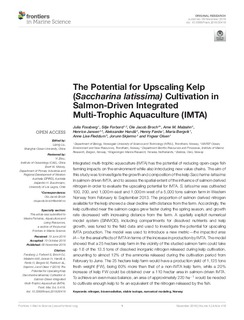| dc.contributor.author | Fossberg, Julia | |
| dc.contributor.author | Forbord, Silje | |
| dc.contributor.author | Broch, Ole Jacob | |
| dc.contributor.author | Malzahn, Arne | |
| dc.contributor.author | Jansen, Henrice M | |
| dc.contributor.author | Handå, Aleksander | |
| dc.contributor.author | Førde, Henny | |
| dc.contributor.author | Bergvik, Maria | |
| dc.contributor.author | Fleddum, Anne Lise | |
| dc.contributor.author | Skjermo, Jorunn | |
| dc.contributor.author | Olsen, Yngvar | |
| dc.date.accessioned | 2019-02-07T10:43:04Z | |
| dc.date.available | 2019-02-07T10:43:04Z | |
| dc.date.created | 2018-11-09T09:17:13Z | |
| dc.date.issued | 2018 | |
| dc.identifier.issn | 2296-7745 | |
| dc.identifier.uri | http://hdl.handle.net/11250/2584306 | |
| dc.description.abstract | Integrated multi-trophic aquaculture (IMTA) has the potential of reducing open-cage fish farming impacts on the environment while also introducing new value chains. The aim of this study was to investigate the growth and composition of the kelp Saccharina latissima in salmon-driven IMTA, and to assess the spatial extent of the influence of salmon derived nitrogen in order to evaluate the upscaling potential for IMTA. S. latissima was cultivated 100, 200, and 1,000 m east and 1,000 m west of a 5,000 tons salmon farm in Western Norway from February to September 2013. The proportion of salmon derived nitrogen available for the kelp showed a clear decline with distance from the farm. Accordingly, the kelp cultivated near the salmon cages grew faster during the spring season, and growth rate decreased with increasing distance from the farm. A spatially explicit numerical model system (SINMOD), including compartments for dissolved nutrients and kelp growth, was tuned to the field data and used to investigate the potential for upscaling IMTA production. The model was used to introduce a new metric—the impacted area IA—for the areal effects of IMTA in terms of the increase in production by IMTA. The model showed that a 25 hectare kelp farm in the vicinity of the studied salmon farm could take up 1.6 of the 13.5 tons of dissolved inorganic nitrogen released during kelp cultivation, amounting to almost 12% of the ammonia released during the cultivation period from February to June. The 25 hectare kelp farm would have a production yield of 1,125 tons fresh weight (FW), being 60% more than that of a non-IMTA kelp farm, while a 20% increase of kelp FW could be obtained over a 110 hectar area in salmon-driven IMTA. To achieve an even mass balance, an area of approximately 220 ha−1 would be needed to cultivate enough kelp to fix an equivalent of the nitrogen released by the fish. | nb_NO |
| dc.language.iso | eng | nb_NO |
| dc.publisher | Frontiers Media | nb_NO |
| dc.rights | Navngivelse 4.0 Internasjonal | * |
| dc.rights.uri | http://creativecommons.org/licenses/by/4.0/deed.no | * |
| dc.title | The Potential for Upscaling Kelp(Saccharina latissima) Cultivation in Salmon-Driven Integrated Multi-Trophic Aquaculture (IMTA) | nb_NO |
| dc.title.alternative | The Potential for Upscaling Kelp(Saccharina latissima) Cultivation in Salmon-Driven Integrated Multi-Trophic Aquaculture (IMTA) | nb_NO |
| dc.type | Journal article | nb_NO |
| dc.type | Peer reviewed | nb_NO |
| dc.description.version | publishedVersion | nb_NO |
| dc.source.journal | Frontiers in Marine Science | nb_NO |
| dc.identifier.cristin | 1628581 | |
| dc.relation.project | Norges forskningsråd: 254883 | nb_NO |
| dc.relation.project | Norges forskningsråd: 216201 | nb_NO |
| dc.description.localcode | Copyright © 2018 Fossberg, Forbord, Broch, Malzahn, Jansen, Handå, Førde, Bergvik, Fleddum, Skjermo and Olsen. This is an open-access article distributed under the terms of the Creative Commons Attribution License (CC BY). | |
| cristin.unitcode | 194,66,10,0 | |
| cristin.unitname | Institutt for biologi | |
| cristin.ispublished | true | |
| cristin.fulltext | original | |
| cristin.qualitycode | 1 | |

